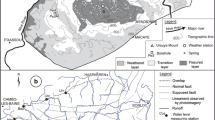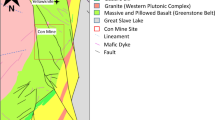Abstract
Water inrush in deep mines is a major problem due to the complicated geological conditions of high water pressure, high stress, and high ground temperature. Because the high ground water and high ground stress have great influence on ground temperature distribution, the temperature change can be used to predict water inrush. In order to use ground temperature to predict water inrush from porous rock under thermal–hydraulic–mechanical (THM) coupling geological environments and simplify the process of establishing THM coupling model, a numerical simulation model specialized for using ground temperature to predict water inrush was established and a software specialized for establishing this model was developed by the secondary development of COMSOL Multiphysics. The temperature change law were studied under the impacts of the interaction of the water pressure, working face length, the geothermal gradient, and fault dip angle. Results indicate that the temperature in porous rock increases with increasing geothermal gradient, water pressure and fault dip angle, and decreases with increasing working face length. The ground temperature is higher in the heterogeneous porous media than in the homogeneous. At high water pressure, the temperature change is very large especially at the first few advancing steps of working face, which can provide an obvious temperature change to predict water inrush from porous rock. The software can provide a more convenient method to establish this model and use ground temperature to predict water inrush from porous rock.
















Similar content being viewed by others
References
Bai J, Li S, Liu R, Zhang Q, Zhang H, Sha F (2015) Multi-field information monitoring and warning of delayed water bursting in deep rock fault. Chin J Rock Mech Eng 34(11):2327–2335
Bear J, Bachmat Y (1990) Introduction to modeling of transport phenomena in porous media. Theory Appl Transp Porous Media 4:481–516
Bond AE, Bruský I, Cao T, Chittenden N, Fedors R, Feng XT, Gwo JP, Kolditz O, Lang P, McDermott C et al (2017) A synthesis of approaches for modelling coupled thermal–hydraulic–mechanical–chemical processes in a single novaculite fracture experiment. Environ Earth Sci 76(1):12
Cao J (2006) The numerical simulating study of working face water inrush theory under high confined water. Dissertation, Shandong University of Science and Technology.
Chen M, Deng X (1990) The map of geothermal gradient of Cenozoic sedimentary cover in the North China plain and its brief explanation. Chin J Geol 3:269–277
Chen M, Xia S, Yang S (1991) Local geothermal anomalies and their formation mechanisms on Leizhou Peninsula, South China. Chin J Geol 4:369–383
Heap MJ, Xu T, Chen CF (2014) The influence of porosity and vesicle size on the brittle strength of volcanic rocks and magma. Bull Volcanol 76(9):856
Jing L, Tsang CF, Stephansson O (1995) DECOVALEX—an international co-operative research project on mathematical models of coupled THM processes for safety analysis of radioactive waste repositories. Int J Rock Mech Min Sci 32(5):389–398
Li W, Liu Y, Qiao W, Zhao C, Yang D, Guo Q (2017) An improved vulnerability assessment model for floor water bursting from a confined aquifer based on the water inrush coefficient method. Mine Water Environ 37(1):11–19
Liu W, Shen J (2016) Experimental study of propagation mode of crack in real rock specimens with a single crack. Chin J Rock Mech Eng 35(6):1182–1189
Mansure AJ, Reiter M (1979) A vertical groundwater movement correction for heat flow. J Geophys Res Solid Earth 84(B7):3490–3496
Papamichos E, Vardoulakis I (2005) Sand erosion with a porosity diffusion law. Comput Geotech 32(1):47–58
Rutqvist J, Wu YS, Tsang CF, Bodvarsson G (2002) A modeling approach for analysis of coupled multiphase fluid flow, heat transfer, and deformation in fractured porous rock. Int J Rock Mech Min Sci 39(4):429–442
SAWSC (State Administration of Work Safety of China) (2009) Coal Mine Water Prevention and Control Regulations. China Coal Industry Publishing House. Beijing, China 84–85
Sun J, Wang L (2013) Floor fault water-inrush prediction based on catastrophe analysis of micro-seismic signals. J China Coal Soc 38(8):1404–1410
Sun J, Wang LG, Tang FR, Shen YF, Gong SL (2011) Micro seismic monitoring failure characteristics of inclined coal seam floor. Rock Soil Mech 32(5):1589–1595
Sun Z, Xin Y, Yao J, Zhang K, Zhuang L, Zhu X et al (2018) Numerical investigation on the heat extraction capacity of dual horizontal wells in enhanced geothermal systems based on the 3-D THM model. Energies 11(2):280
Tang CA, Liu HY (2000) Influence of heterogeneity on crack propagation modes in brittle rock. Chin J Geophys 43(1):117–125
Tsang CF, Jing L, Stephansson O, Kautsky F (2005) The DECOVALEX III project: a summary of activities and lessons learned. Int J Rock Mech Min Sci 42(5–6):593–610
Wang QY, Zhu WC, Xu T, Niu LL, Wei J (2016) Numerical simulation of rock creep behavior with a damage-based constitutive law. Int J Geomech 17(1):04016044
Xiao Y, Guo J, Wang H, Lu L, Mclennan J, Chen M (2018) Coupled THM and matrix stability modeling of hydroshearing stimulation in a coupled fracture-matrix hot volcanic system. Math Probl Eng 2018:3015015. https://doi.org/10.1155/2018/3015015
Yang T, Chen S, Zhu W, Meng Z, Gao Y (2008) Water inrush mechanism in mines and nonlinear flow model for fractured rocks. Chin J Rock Mech Eng 27(7):1411–1416
Yu S (2015) Transient electromagnetic method detecting technology of water-bearing occurence of aquifers in three-soft coal seam overlying rocks. Coal Sci Technol 43(1):104–107 + 73
Zhang S, Guo W, Li Y, Sun W, Yin D (2017) Experimental simulation of fault water inrush channel evolution in a coal mine floor. Mine Water Environ 36(3):443–451
Zhang Y, Yang C, Xu G (2012) FEM analysis for influences of a fault on coupled T–H–M–M process in dual-porosity rock mass. Rock Soil Mech 25(6):651–662
Zhou Q, Herrera J, Hidalgo A (2018) The numerical analysis of fault-induced mine water inrush using the extended finite element method and fracture mechanics. Mine Water Environ 37(1):185–195
Zhu WC, Tang CA (2004) Micromechanical model for simulating the fracture process of rock. Rock Mech Rock Eng 37(1):25–56
Acknowledgements
This research was supported by the Shandong Higher Education Teaching Reform Research Project of China (Grant 2015M138), and Ministry of Education, Higher Education Department, Industry, Education and Research Collaborative Education Project of China (Grant 201802197019).
Author information
Authors and Affiliations
Corresponding author
Additional information
Publisher's Note
Springer Nature remains neutral with regard to jurisdictional claims in published maps and institutional affiliations.
Rights and permissions
About this article
Cite this article
Nie, R., Li, M., Yu, J. et al. A Numerical Simulation Model and a Software of Using Ground Temperature to Predict Water Inrush from Heterogeneous Porous Rocks. Geotech Geol Eng 38, 4567–4583 (2020). https://doi.org/10.1007/s10706-020-01311-8
Received:
Accepted:
Published:
Issue Date:
DOI: https://doi.org/10.1007/s10706-020-01311-8




